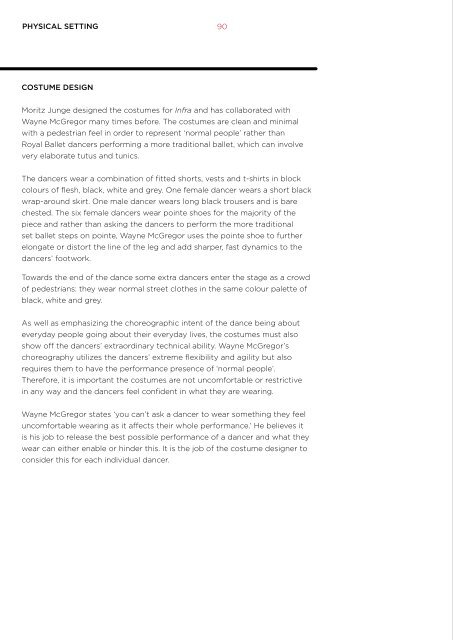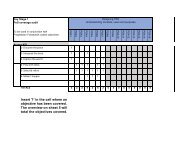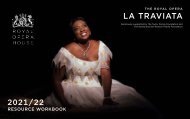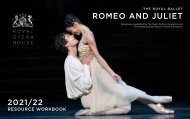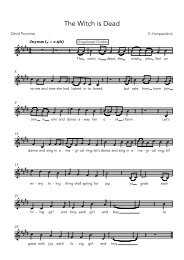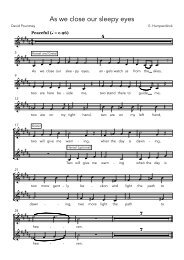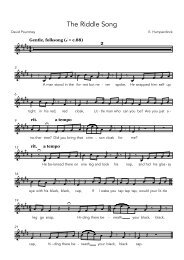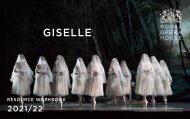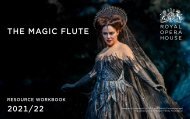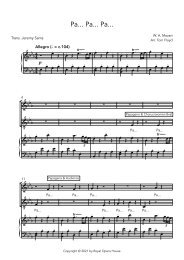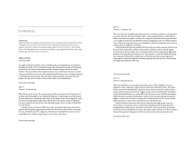Infra GCSE Resource
Create successful ePaper yourself
Turn your PDF publications into a flip-book with our unique Google optimized e-Paper software.
PHYSICAL SETTING<br />
90<br />
COSTUME DESIGN<br />
Moritz Junge designed the costumes for <strong>Infra</strong> and has collaborated with<br />
Wayne McGregor many times before. The costumes are clean and minimal<br />
with a pedestrian feel in order to represent ‘normal people’ rather than<br />
Royal Ballet dancers performing a more traditional ballet, which can involve<br />
very elaborate tutus and tunics.<br />
The dancers wear a combination of fitted shorts, vests and t-shirts in block<br />
colours of flesh, black, white and grey. One female dancer wears a short black<br />
wrap-around skirt. One male dancer wears long black trousers and is bare<br />
chested. The six female dancers wear pointe shoes for the majority of the<br />
piece and rather than asking the dancers to perform the more traditional<br />
set ballet steps on pointe, Wayne McGregor uses the pointe shoe to further<br />
elongate or distort the line of the leg and add sharper, fast dynamics to the<br />
dancers’ footwork.<br />
Towards the end of the dance some extra dancers enter the stage as a crowd<br />
of pedestrians: they wear normal street clothes in the same colour palette of<br />
black, white and grey.<br />
As well as emphasizing the choreographic intent of the dance being about<br />
everyday people going about their everyday lives, the costumes must also<br />
show off the dancers’ extraordinary technical ability. Wayne McGregor’s<br />
choreography utilizes the dancers’ extreme flexibility and agility but also<br />
requires them to have the performance presence of ‘normal people’.<br />
Therefore, it is important the costumes are not uncomfortable or restrictive<br />
in any way and the dancers feel confident in what they are wearing.<br />
‘My work for the <strong>Infra</strong> principal costumes was<br />
very much a translation of Julian’s icon-type figures<br />
into a ballet costume. This sounds straightforward<br />
but actually never is, because all dancers and<br />
human bodies pretty much have their own rules<br />
of proportion in costume terms… plus I must<br />
consider the materials The Royal Ballet has to use<br />
for durability and so on. By developing prototypes<br />
we fitted and tested lots of different shapes on the<br />
dancers. I then narrowed these down and designed<br />
the costumes that proved right for Wayne’s<br />
choreography and the overall look of the show.<br />
It’s a step-by-step processes working alongside<br />
all collaborators and the dancers, developing<br />
and designing from sometimes an individual and<br />
ambiguous starting point but always ending with<br />
a strong costume idea and product that you see<br />
on stage.’<br />
Moritz Junge<br />
Johannes Stepanek in <strong>Infra</strong><br />
©ROH/Bill Cooper, 2010<br />
Wayne McGregor states ‘you can’t ask a dancer to wear something they feel<br />
uncomfortable wearing as it affects their whole performance.’ He believes it<br />
is his job to release the best possible performance of a dancer and what they<br />
wear can either enable or hinder this. It is the job of the costume designer to<br />
consider this for each individual dancer.


